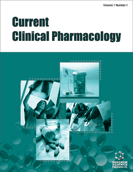Abstract
The enzyme poly(ADP)-ribose polymerase-1 (PARP-1) plays an important role in the repair of DNA damage via a mechanism called base excision repair (BER). Initially, inhibition of PARP-1 showed to be a promising anti-tumor strategy in preclinical models using BRCA1 and BRCA2 deficient tumor cell lines. More recently, several small molecules targeting PARP-1 entered the clinic and demonstrated compelling anti-tumor activity in patients with BRCA deficient breast and ovarian cancers, and in patients with triple-negative breast cancer. In this review we aim to summarize the most recent advances in the development of PARP inhibitors, with a focus on the clinical data.
Keywords: Synthetic lethality, repair mechanism, PARP, BRCA deficient, olaparib
Current Clinical Pharmacology
Title: Inducing Synthetic Lethality using PARP Inhibitors
Volume: 5 Issue: 3
Author(s): David S. Boss, Jos H. Beijnen and Jan H.M. Schellens
Affiliation:
Keywords: Synthetic lethality, repair mechanism, PARP, BRCA deficient, olaparib
Abstract: The enzyme poly(ADP)-ribose polymerase-1 (PARP-1) plays an important role in the repair of DNA damage via a mechanism called base excision repair (BER). Initially, inhibition of PARP-1 showed to be a promising anti-tumor strategy in preclinical models using BRCA1 and BRCA2 deficient tumor cell lines. More recently, several small molecules targeting PARP-1 entered the clinic and demonstrated compelling anti-tumor activity in patients with BRCA deficient breast and ovarian cancers, and in patients with triple-negative breast cancer. In this review we aim to summarize the most recent advances in the development of PARP inhibitors, with a focus on the clinical data.
Export Options
About this article
Cite this article as:
S. Boss David, H. Beijnen Jos and H.M. Schellens Jan, Inducing Synthetic Lethality using PARP Inhibitors, Current Clinical Pharmacology 2010; 5 (3) . https://dx.doi.org/10.2174/157488410791498798
| DOI https://dx.doi.org/10.2174/157488410791498798 |
Print ISSN 1574-8847 |
| Publisher Name Bentham Science Publisher |
Online ISSN 2212-3938 |
 16
16Related Articles
-
Arylurea Derivatives: A Class of Potential Cancer Targeting Agents
Current Topics in Medicinal Chemistry Selective Matrix Metalloproteinase Inhibitors for Cancer
Current Medicinal Chemistry Effects of Specific Cyclooxygenase-2 Inhibitors on Carcinogenesis
Medicinal Chemistry Reviews - Online (Discontinued) The Repurposing of Old Drugs or Unsuccessful Lead Compounds by in Silico Approaches: New Advances and Perspectives
Current Topics in Medicinal Chemistry The Roles of Mesenchymal Stem Cells in Tissue Repair and Disease Modification
Current Stem Cell Research & Therapy Antisense Treatment in Human Prostate Cancer and Melanoma
Current Cancer Drug Targets Synthesis and Hypoxia Selective Radiosensitization Potential of β-2-FAZA and β-3-FAZL: Fluorinated Azomycin β-Nucleosides
Medicinal Chemistry Pharmacological Targeting of the Inflamed Intestinal Barrier
Current Pharmaceutical Design Targeting Autophagic Pathways by Plant Natural Compounds in Cancer Treatment
Current Drug Targets Current Protein-based Anti-angiogenic Therapeutics
Mini-Reviews in Medicinal Chemistry Comment on the Paper Entitled: “Tumorous Spinal Lesions: Computer Aided Diagnosis and Evaluation Based on CT Data - a Review”
Current Medical Imaging Smart Inulin-Based Polycationic Nanodevices for siRNA Delivery
Current Drug Delivery Development of Taxol and Other Endophyte Produced Anti-Cancer Agents
Recent Patents on Anti-Cancer Drug Discovery Targeting JAK3 Tyrosine Kinase-Linked Signal Transduction Pathways with Rationally-Designed Inhibitors
Anti-Cancer Agents in Medicinal Chemistry C-20 Cyclopropyl Vitamin D3 Analogs
Current Topics in Medicinal Chemistry Future Prospect of RNA Interference for Cancer Therapies
Current Drug Targets Persistent GP130/STAT3 Signaling Contributes to the Resistance of Doxorubicin, Cisplatin, and MEK Inhibitor in Human Rhabdomyosarcoma Cells
Current Cancer Drug Targets Non-Steroidal Anti-Inflammatory Drugs (NSAIDs) Induced Dyspepsia
Current Pharmaceutical Design A Concise Review of Current Radiopharmaceuticals in Tumor Angiogenesis Imaging
Current Pharmaceutical Design STAT 3 as a Target for Cancer Drug Discovery
Current Medicinal Chemistry






















